Ali Athar
How Important are Videos for Training Video LLMs?
Jun 07, 2025Abstract:Research into Video Large Language Models (LLMs) has progressed rapidly, with numerous models and benchmarks emerging in just a few years. Typically, these models are initialized with a pretrained text-only LLM and finetuned on both image- and video-caption datasets. In this paper, we present findings indicating that Video LLMs are more capable of temporal reasoning after image-only training than one would assume, and that improvements from video-specific training are surprisingly small. Specifically, we show that image-trained versions of two LLMs trained with the recent LongVU algorithm perform significantly above chance level on TVBench, a temporal reasoning benchmark. Additionally, we introduce a simple finetuning scheme involving sequences of annotated images and questions targeting temporal capabilities. This baseline results in temporal reasoning performance close to, and occasionally higher than, what is achieved by video-trained LLMs. This suggests suboptimal utilization of rich temporal features found in real video by current models. Our analysis motivates further research into the mechanisms that allow image-trained LLMs to perform temporal reasoning, as well as into the bottlenecks that render current video training schemes inefficient.
COCONut-PanCap: Joint Panoptic Segmentation and Grounded Captions for Fine-Grained Understanding and Generation
Feb 04, 2025Abstract:This paper introduces the COCONut-PanCap dataset, created to enhance panoptic segmentation and grounded image captioning. Building upon the COCO dataset with advanced COCONut panoptic masks, this dataset aims to overcome limitations in existing image-text datasets that often lack detailed, scene-comprehensive descriptions. The COCONut-PanCap dataset incorporates fine-grained, region-level captions grounded in panoptic segmentation masks, ensuring consistency and improving the detail of generated captions. Through human-edited, densely annotated descriptions, COCONut-PanCap supports improved training of vision-language models (VLMs) for image understanding and generative models for text-to-image tasks. Experimental results demonstrate that COCONut-PanCap significantly boosts performance across understanding and generation tasks, offering complementary benefits to large-scale datasets. This dataset sets a new benchmark for evaluating models on joint panoptic segmentation and grounded captioning tasks, addressing the need for high-quality, detailed image-text annotations in multi-modal learning.
ViCaS: A Dataset for Combining Holistic and Pixel-level Video Understanding using Captions with Grounded Segmentation
Dec 12, 2024



Abstract:Recent advances in multimodal large language models (MLLMs) have expanded research in video understanding, primarily focusing on high-level tasks such as video captioning and question-answering. Meanwhile, a smaller body of work addresses dense, pixel-precise segmentation tasks, which typically involve category-guided or referral-based object segmentation. Although both research directions are essential for developing models with human-level video comprehension, they have largely evolved separately, with distinct benchmarks and architectures. This paper aims to unify these efforts by introducing ViCaS, a new dataset containing thousands of challenging videos, each annotated with detailed, human-written captions and temporally consistent, pixel-accurate masks for multiple objects with phrase grounding. Our benchmark evaluates models on both holistic/high-level understanding and language-guided, pixel-precise segmentation. We also present carefully validated evaluation measures and propose an effective model architecture that can tackle our benchmark. Project page: https://ali2500.github.io/vicas-project/
4D-Former: Multimodal 4D Panoptic Segmentation
Nov 17, 2023



Abstract:4D panoptic segmentation is a challenging but practically useful task that requires every point in a LiDAR point-cloud sequence to be assigned a semantic class label, and individual objects to be segmented and tracked over time. Existing approaches utilize only LiDAR inputs which convey limited information in regions with point sparsity. This problem can, however, be mitigated by utilizing RGB camera images which offer appearance-based information that can reinforce the geometry-based LiDAR features. Motivated by this, we propose 4D-Former: a novel method for 4D panoptic segmentation which leverages both LiDAR and image modalities, and predicts semantic masks as well as temporally consistent object masks for the input point-cloud sequence. We encode semantic classes and objects using a set of concise queries which absorb feature information from both data modalities. Additionally, we propose a learned mechanism to associate object tracks over time which reasons over both appearance and spatial location. We apply 4D-Former to the nuScenes and SemanticKITTI datasets where it achieves state-of-the-art results.
TarViS: A Unified Approach for Target-based Video Segmentation
Jan 06, 2023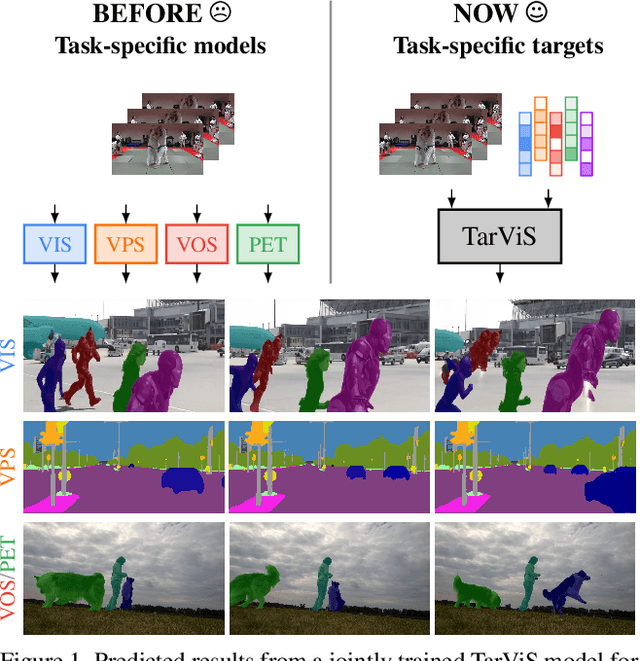



Abstract:The general domain of video segmentation is currently fragmented into different tasks spanning multiple benchmarks. Despite rapid progress in the state-of-the-art, current methods are overwhelmingly task-specific and cannot conceptually generalize to other tasks. Inspired by recent approaches with multi-task capability, we propose TarViS: a novel, unified network architecture that can be applied to any task that requires segmenting a set of arbitrarily defined 'targets' in video. Our approach is flexible with respect to how tasks define these targets, since it models the latter as abstract 'queries' which are then used to predict pixel-precise target masks. A single TarViS model can be trained jointly on a collection of datasets spanning different tasks, and can hot-swap between tasks during inference without any task-specific retraining. To demonstrate its effectiveness, we apply TarViS to four different tasks, namely Video Instance Segmentation (VIS), Video Panoptic Segmentation (VPS), Video Object Segmentation (VOS) and Point Exemplar-guided Tracking (PET). Our unified, jointly trained model achieves state-of-the-art performance on 5/7 benchmarks spanning these four tasks, and competitive performance on the remaining two.
BURST: A Benchmark for Unifying Object Recognition, Segmentation and Tracking in Video
Sep 25, 2022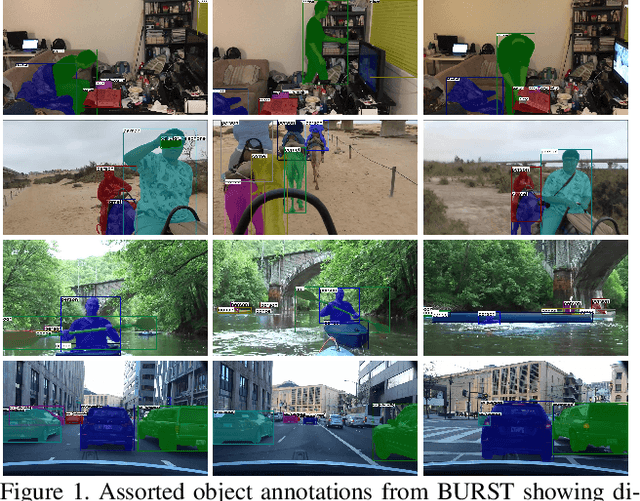
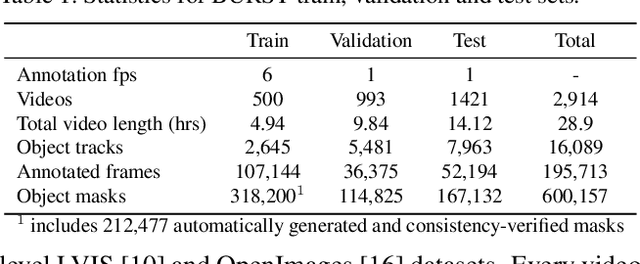


Abstract:Multiple existing benchmarks involve tracking and segmenting objects in video e.g., Video Object Segmentation (VOS) and Multi-Object Tracking and Segmentation (MOTS), but there is little interaction between them due to the use of disparate benchmark datasets and metrics (e.g. J&F, mAP, sMOTSA). As a result, published works usually target a particular benchmark, and are not easily comparable to each another. We believe that the development of generalized methods that can tackle multiple tasks requires greater cohesion among these research sub-communities. In this paper, we aim to facilitate this by proposing BURST, a dataset which contains thousands of diverse videos with high-quality object masks, and an associated benchmark with six tasks involving object tracking and segmentation in video. All tasks are evaluated using the same data and comparable metrics, which enables researchers to consider them in unison, and hence, more effectively pool knowledge from different methods across different tasks. Additionally, we demonstrate several baselines for all tasks and show that approaches for one task can be applied to another with a quantifiable and explainable performance difference. Dataset annotations and evaluation code is available at: https://github.com/Ali2500/BURST-benchmark.
Differentiable Soft-Masked Attention
Jun 01, 2022


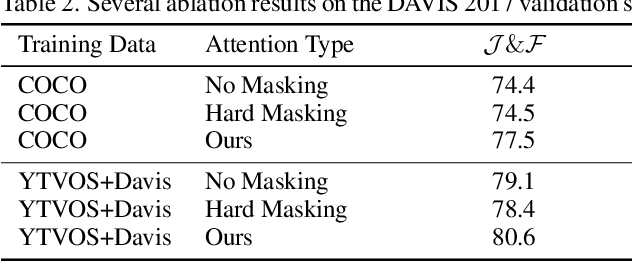
Abstract:Transformers have become prevalent in computer vision due to their performance and flexibility in modelling complex operations. Of particular significance is the 'cross-attention' operation, which allows a vector representation (e.g. of an object in an image) to be learned by attending to an arbitrarily sized set of input features. Recently, "Masked Attention" was proposed in which a given object representation only attends to those image pixel features for which the segmentation mask of that object is active. This specialization of attention proved beneficial for various image and video segmentation tasks. In this paper, we propose another specialization of attention which enables attending over `soft-masks' (those with continuous mask probabilities instead of binary values), and is also differentiable through these mask probabilities, thus allowing the mask used for attention to be learned within the network without requiring direct loss supervision. This can be useful for several applications. Specifically, we employ our "Differentiable Soft-Masked Attention" for the task of Weakly-Supervised Video Object Segmentation (VOS), where we develop a transformer-based network for VOS which only requires a single annotated image frame for training, but can also benefit from cycle consistency training on a video with just one annotated frame. Although there is no loss for masks in unlabeled frames, the network is still able to segment objects in those frames due to our novel attention formulation.
HODOR: High-level Object Descriptors for Object Re-segmentation in Video Learned from Static Images
Dec 16, 2021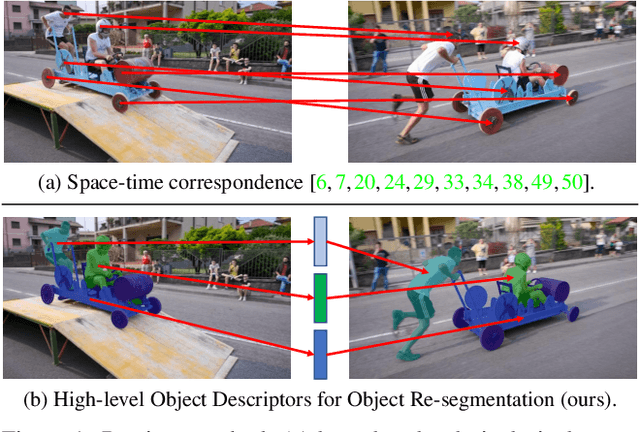
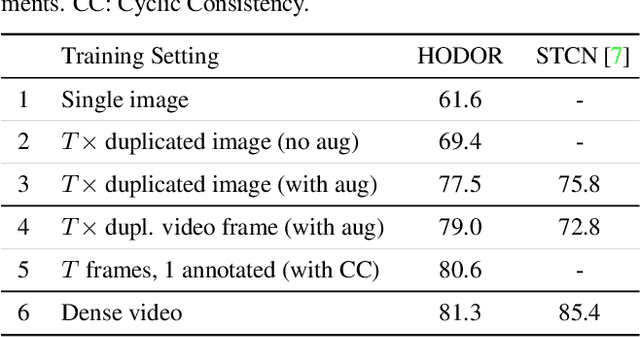

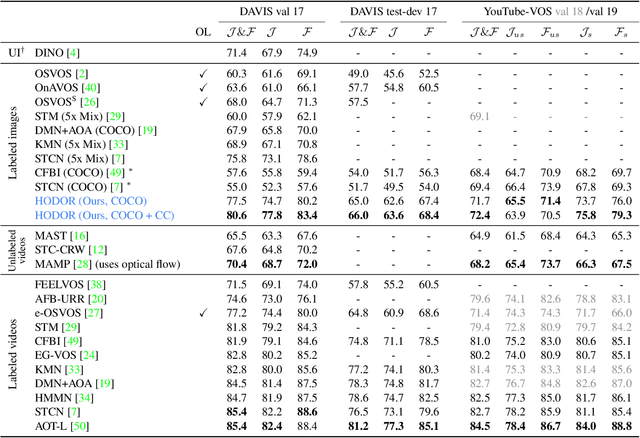
Abstract:Existing state-of-the-art methods for Video Object Segmentation (VOS) learn low-level pixel-to-pixel correspondences between frames to propagate object masks across video. This requires a large amount of densely annotated video data, which is costly to annotate, and largely redundant since frames within a video are highly correlated. In light of this, we propose HODOR: a novel method that tackles VOS by effectively leveraging annotated static images for understanding object appearance and scene context. We encode object instances and scene information from an image frame into robust high-level descriptors which can then be used to re-segment those objects in different frames. As a result, HODOR achieves state-of-the-art performance on the DAVIS and YouTube-VOS benchmarks compared to existing methods trained without video annotations. Without any architectural modification, HODOR can also learn from video context around single annotated video frames by utilizing cyclic consistency, whereas other methods rely on dense, temporally consistent annotations.
D^2Conv3D: Dynamic Dilated Convolutions for Object Segmentation in Videos
Nov 15, 2021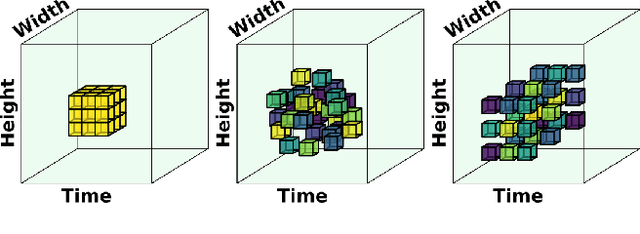
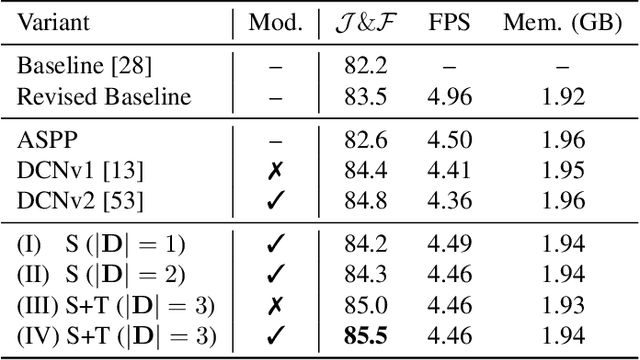
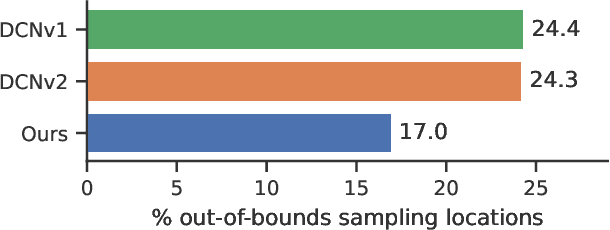

Abstract:Despite receiving significant attention from the research community, the task of segmenting and tracking objects in monocular videos still has much room for improvement. Existing works have simultaneously justified the efficacy of dilated and deformable convolutions for various image-level segmentation tasks. This gives reason to believe that 3D extensions of such convolutions should also yield performance improvements for video-level segmentation tasks. However, this aspect has not yet been explored thoroughly in existing literature. In this paper, we propose Dynamic Dilated Convolutions (D^2Conv3D): a novel type of convolution which draws inspiration from dilated and deformable convolutions and extends them to the 3D (spatio-temporal) domain. We experimentally show that D^2Conv3D can be used to improve the performance of multiple 3D CNN architectures across multiple video segmentation related benchmarks by simply employing D^2Conv3D as a drop-in replacement for standard convolutions. We further show that D^2Conv3D out-performs trivial extensions of existing dilated and deformable convolutions to 3D. Lastly, we set a new state-of-the-art on the DAVIS 2016 Unsupervised Video Object Segmentation benchmark. Code is made publicly available at https://github.com/Schmiddo/d2conv3d .
Making a Case for 3D Convolutions for Object Segmentation in Videos
Aug 26, 2020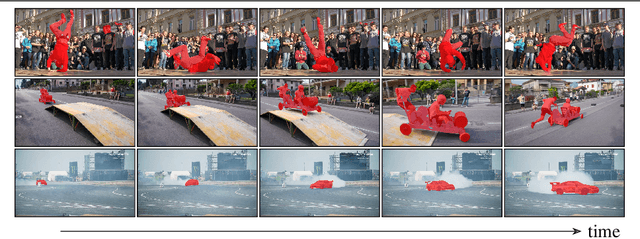
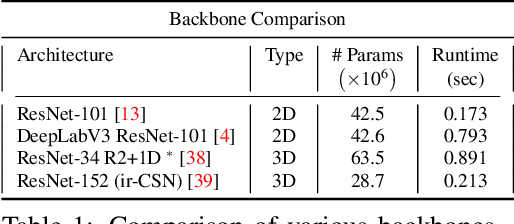
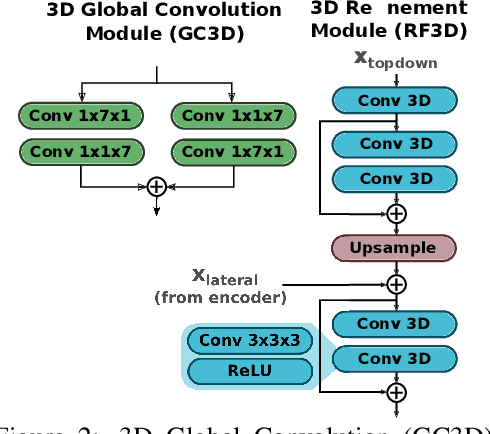
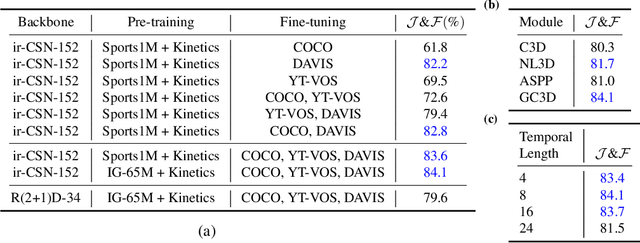
Abstract:The task of object segmentation in videos is usually accomplished by processing appearance and motion information separately using standard 2D convolutional networks, followed by a learned fusion of the two sources of information. On the other hand, 3D convolutional networks have been successfully applied for video classification tasks, but have not been leveraged as effectively to problems involving dense per-pixel interpretation of videos compared to their 2D convolutional counterparts and lag behind the aforementioned networks in terms of performance. In this work, we show that 3D CNNs can be effectively applied to dense video prediction tasks such as salient object segmentation. We propose a simple yet effective encoder-decoder network architecture consisting entirely of 3D convolutions that can be trained end-to-end using a standard cross-entropy loss. To this end, we leverage an efficient 3D encoder, and propose a 3D decoder architecture, that comprises novel 3D Global Convolution layers and 3D Refinement modules. Our approach outperforms existing state-of-the-arts by a large margin on the DAVIS'16 Unsupervised, FBMS and ViSal dataset benchmarks in addition to being faster, thus showing that our architecture can efficiently learn expressive spatio-temporal features and produce high quality video segmentation masks. Our code and models will be made publicly available.
 Add to Chrome
Add to Chrome Add to Firefox
Add to Firefox Add to Edge
Add to Edge